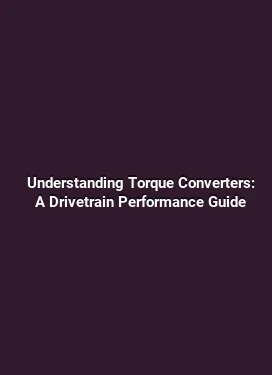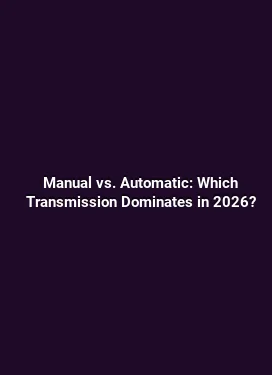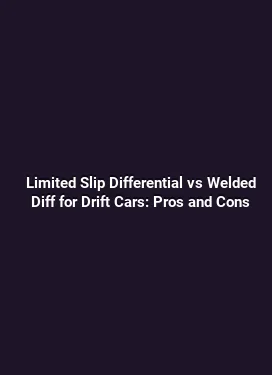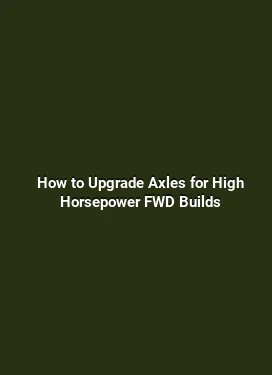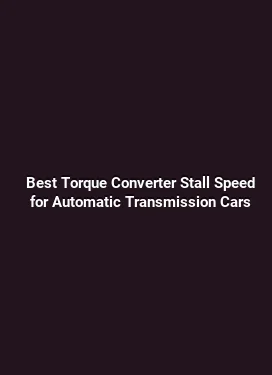How to Upgrade Half Shafts and CV Joints for High Torque
When increasing a vehicle’s torque output, the drivetrain must be able to transfer power reliably without introducing unwanted vibrations, binding, or premature wear. Upgrading half shafts and constant velocity (CV) joints is a common path for enthusiasts seeking stronger acceleration, improved launch performance, and durable high-torque capability. This guide dives into the essentials of selecting robust components, evaluating torque and duty cycles, and performing upgrades with real-world considerations and practical tips.
Understanding Torque Demands and Drivetrain Fatigue

Before diving into component selection, it is crucial to understand the torque profile your setup will encounter. Peak torque matters, but so do sustained torque, engine torque curve, gear ratios, and the behavior of the differential. A high-torque application places extra stress on inner and outer CV joints, half shafts, and the splines that connect them to hubs and gearsets. The goal is to maintain smooth power transfer under load, minimize play, and prevent binding or snap failures during aggressive shifts, hard launches, or off-road traction events.
Key signs of drivetrain fatigue include uneven joint wear, clicking or clunking under steering input, and increased vibration at certain RPM ranges. When planning upgrades, map out expected load cycles: daily commuting with occasional hard launches, drag racing, hill climbs, or off-road courses. Matching the right materials (heat-treated alloys, robust cages, and optimized CV joint geometry) to the duty cycle improves reliability and longevity.
Choosing Upgraded Half Shafts and CV Joints: Core Considerations
Upgrading to high-torque capable half shafts and CV joints involves balancing strength, weight, smoothness, and cost. The following considerations help guide component selection.
Material and Construction

High-torque applications benefit from shafts constructed from heat-treated alloy steels with refined geometry. Look for CV joints with robust ball bearings or needle bearings, heavy-duty cages, and outer races that resist spalling under high load. A common upgrade path is to choose CV joints with larger ball diameters, thicker races, and improved grease retention. These features reduce friction, improve durability, and extend service life under aggressive acceleration and cornering loads.
Joint Design and Longevity
Understanding the difference between tripod, Rzeppa, and plunge CV joints helps in selecting the right design for a given vehicle. Tripod joints are known for high-angle flexibility and low friction at extreme suspension travel, while Rzeppa joints excel in smooth power transmission with good load distribution. For high-torque builds, a design with reinforced races and improved grease channels reduces heat buildup during sustained hard driving. Proper boot design and grease compatibility are also critical to keep contaminants out and lubrication in, which directly affects joint life.
Spline Fitment and Hubs
The interface between the shaft and the hub is a common failure point under heavy loads. Ensuring a tight spline fit, adequate engagement length, and compatible hub bore geometry minimizes slippage. Some upgraded half shafts feature thicker splines, splined adaptors, or reinforced inner joints to accommodate high torque without increasing play. When selecting shafts, verify compatibility with your vehicle’s hub style, ABS tone rings, and wheel studs to avoid fitment issues during installation.
Drive Axle Geometry and Drivetrain Options
Upgrading often interacts with the car’s differential, transmission, and suspension geometry. A limited-slip differential (LSD) or a torque-biased coupling can shift load paths and influence joint angles. In some setups, longer or shorter shafts alter suspension travel and CV angle, so it is essential to recalculate CV angles and ensure adequate clearance across steering extremes and suspension articulation. Proper alignment reduces U-joint or CV joint wear and helps maintain consistent traction.
Practical Upgrades: Step-by-Step Pathways
Upgrading should be approached methodically. The following pathways outline practical routes for different goals and budgets, with emphasis on real-world execution and reliability.
Pathway A: Moderate Torque Increase for Daily Driven Cars
For drivers seeking reliable improvement without drastic changes to driveline behavior, consider reinforced CV joints and mid-range half shafts designed for higher torque than stock. Steps include measuring existing shaft length, confirming spline counts, and selecting joints with robust grease seals and improved boot clamps. Prepare for a careful axle pull and reinstallation, paying attention to inner race seating and boot alignment to prevent boot damage during reassembly.
Advantages include better durability under spirited driving and improved confidence during corner exits while maintaining factory-like smoothness. This approach minimizes changes to suspension geometry and reduces the risk of driveline vibrations that could surface at highway speeds.
Pathway B: High Torque for Performance Street/Track Use
In performance-oriented builds, a complete half-shaft and CV joint upgrade can deliver meaningful gains in power transfer and response. Choose components with higher torque ratings, stronger inner joints, and reinforced outer joints capable of handling aggressive launches. Pay particular attention to lubrication, sealing, and heat management since high torque often correlates with elevated operating temperatures in the joints.
During installation, verify that drivetrain alignment remains within manufacturer tolerances and that the CV axle boot clearances do not contact suspension components at full steering lock. Consider upgrading to a limited-slip differential to complement the increased traction and reduce torque steer, especially on front-wheel-drive platforms.
Pathway C: All-Terrain or Drag-Specific Upgrades
Off-road or drag-focused builds demand the strongest possible joints and longer-lasting half shafts. Prioritize CV joints with thicker cages, larger ball routing, and enhanced grease channels, along with half shafts that use heat-treated alloys and enhanced splines. Inspect boot geometry and ensure improved heat dissipation through proper venting or heat shields if the drivetrain operates in extreme environments.
In these scenarios, a robust hub and carrier assembly may also be warranted to manage stress concentrations around bearing seats. Regular inspections for heat cracking or discoloration on the joints help prevent unexpected failure during critical moments on the trail or track.
Installation Essentials: Tools, Steps, and Best Practices
Installation quality determines whether upgraded components deliver their expected lifespan and performance. The following guidelines are pragmatic, field-tested steps for a successful upgrade.
Preparation and Safety
Work in a clean, well-lit area with the vehicle securely lifted and supported. Wear eye protection and gloves. Disconnect the battery to avoid any electrical hazards while handling components near ignition or sensors. Clean the work area to prevent debris from entering bearing races or CV joint seals during disassembly.
Gather the necessary tools: torque wrench, hub puller or slide hammer, circlip pliers, pry tools, pliers for boot clamps, and a torque specification reference for your vehicle. Have replacement grease, boots, clamps, and any required seals on hand. Inspect the transmission side of the shaft for splines and cleanliness before installation.
Disassembly and Inspection
Carefully remove the existing half shafts and CV joints, noting the orientation and the alignment marks. Inspect the inner races, splines, and bearing surfaces for wear, pitting, or corrosion. Replace any worn components with identical or compatible upgraded parts, as mismatched tolerances can cause vibrations or uneven wear. Clean all mating surfaces and lightly lubricate non-sealing contact points with manufacturer-approved grease to prevent corrosion.
When reassembling, ensure the CV boot is seated correctly and the boot clamps are secure. Verify there is no binding or excessive resistance when rotating the joints by hand before driving the vehicle. A dry run with the vehicle on stands helps detect obvious issues before road testing.
Torque and Alignment Checks
Correct torque application is essential. Use the vehicle’s service manual as a primary reference, and apply bolts to the specified values with even, star-pattern tightening when applicable. After installation, an alignment check is advisable to confirm that no drivetrain angles (CV angle, pinion angle, or driveshaft angles) are outside recommended ranges. This reduces noise and wear during operation.
Maintenance and Monitoring for Long-Term Reliability
Upgraded half shafts and CV joints demand ongoing attention. Regular inspection, proper lubrication, and clean operation extend life and preserve performance gains.
Schedule periodic checks for boot integrity, grease leakage, and joint play. If any cracking, hardening of grease, or unusual heat is detected, address it promptly. High-torque setups may benefit from higher-grade grease compatible with elevated temperatures, along with boot clamps that resist loosening under dynamic loads. Temperature management can also influence longevity; consider heat shields or improved ventilation around the joint area when track or off-road duties are frequent.
Diagnostics and Troubleshooting: Common Scenarios
Several typical symptoms point to upgrade-related issues or installation errors. Recognizing these early helps prevent driveline damage and costly repairs.
Excessive vibration under acceleration often indicates CV angle misalignment, worn inner races, or improper boot installation. Clicking or popping noises during sharp turns may signal joint wear or lubrication problems. A persistent clunking sound when shifting from idle to power or during aggressive takeoffs can indicate loose hub mounting or worn splines. If steering response changes after the upgrade, check for binding joints or drivetrain misalignment that affects the steering geometry.
Cost Considerations and Budgeting for Upgrades
Investing in high-torque capable half shafts and CV joints requires a realistic budget that accounts for parts, tools, and potential ancillary upgrades. High-quality components frequently come with longer warranties and better heat resistance, offsetting maintenance costs over time. Plan for professional installation if the drivetrain is unfamiliar or if the vehicle has advanced electronics, such as adaptive all-wheel-drive systems, that require careful calibration after hardware changes.
Compare bundled upgrade kits versus individual components to assess value. In some cases, replacing related items—such as wheel bearings, hub assemblies, or even the differential seals—at the same time can reduce labor costs and minimize rework. Tactical planning reduces downtime and ensures the upgraded system delivers consistent performance on the road or track.
Conclusion-Free Reflection: Real-World Takeaways
Upgrading half shafts and CV joints for high-torque applications is a practical strategy to improve power delivery, traction, and reliability. Through careful component selection, precise installation, and prudent maintenance, drivers can achieve greater durability and a more confident driving experience under demanding conditions. The path chosen should align with the vehicle’s intended use, the expected duty cycle, and the overall drivetrain architecture.
Notes on Compatibility and Customization
Compatibility is a cornerstone of a successful upgrade. Always verify the parts’ compatibility with your vehicle’s make, model, and year, including differential type, hub design, and wheel dimensions. Customization options, such as different CV joint angles or hub adapters, require careful measurement and sometimes professional calibration to avoid interference with braking systems or suspension components. A thorough compatibility check reduces surprises during installation and helps maintain ride quality during high-load scenarios.


